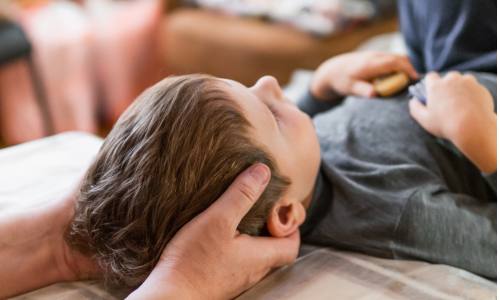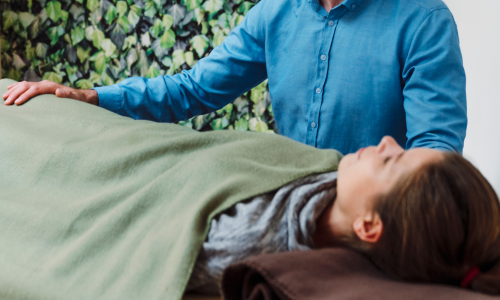Biodynamic Craniosacral Therapy (BCST)
FREQUENTLY ASKED QUESTIONS
What is BCST?
Who can benefit from Biodynamic Craniosacral Therapy?
Is Biodynamic Craniosacral Therapy safe for children?
Is Biodynamic Craniosacral Therapy safe during pregnancy?
Are “manipulations” involved in Biodynamic Craniosacral Therapy?
How can I benefit from Biodynamic Craniosacral Therapy?
How does Biodynamic Craniosacral Therapy work?
What symptoms respond best to Biodynamic Craniosacral Therapy?
How many sessions will I need?
Why do I fall asleep during my sessions?
Does insurance cover Biodynamic Craniosacral Therapy?
What is BCST?
Biodynamic Craniosacral Therapy is a gentle non-invasive, hands-on session for the whole body. Performed on a massage table, the client is fully clothed and the practitioner touch is light and still. The session focus is to support the inherent health of the whole being, especially the nervous system (NS). The NS dictates all of the body’s functioning, constantly sending and receiving information.
Biodynamic Craniosacral practitioners understand how an optimally functioning healthy nervous system performs. We are trained for years on how to use acute perception skills to perceive subtle physiological changes. We also are aware of the energetic map that underlies one‘s basic health and symptomology. We believe that health is never lost no matter what the ailment. We use our ability to identify the parts of the nervous system that are not functioning optimally and our awareness of the “always available health” in the body to assist the system in bringing itself back into balance. This supports greater ease and helps the body decrease symptoms.
Who can benefit from Biodynamic Craniosacral Therapy?
Because of the gentle non-invasive nature of Biodynamic Craniosacral Therapy (BCST), there are few contraindications for treatment. Everyone can benefit - the work can enjoyed by newborns, elders, the frail or those who are ill. The improvement after a session may be subtle or dramatic. BCST encourages health in the brain and nervous system, has been known to be effective in assisting the prevention of chronic conditions.
 In addition, BCST can be useful in addressing injuries, including those to the bones and tissues. BCST is also an effective modality for exploring and resolving issues of the past including prenatal and birth trauma. Early trauma can create an unconscious belief system that is not relevant in the adult. BCST allows the acknowledgement of out moded beliefs and shifting to real or appropriate beliefs. In addition, BCST can be useful in addressing injuries, including those to the bones and tissues. BCST is also an effective modality for exploring and resolving issues of the past including prenatal and birth trauma. Early trauma can create an unconscious belief system that is not relevant in the adult. BCST allows the acknowledgement of out moded beliefs and shifting to real or appropriate beliefs.
How many of us have experienced a head or tailbone injury, accidents, minor or major surgeries, and dental work? Life experiences can create emotional trauma, physical strains and anesthesia residues. The biodynamic approach strengthens the whole system, creating a safe environment for the body to gain new perspectives and a healthy resolution of issues. The Biodynamic Craniosacral practitioner is a facilitator for resolution. Our innate inner health is capable of re-patterning toward health in an order of priorities initiated by the body, a titrated shift to prevent overwhelm. It is not necessary to remember, re-experience, or relive trauma in order to gain resolution.
return to top
Is Biodynamic Craniosacral Therapy safe for children?
Children respond well to BCST because it is gentle, non-invasive, and effective in ways they can intuitively recognize. Even small children quickly get used to the work as they develop trust in their practitioner. Pre-verbal children may actually direct the practitioner’s hands to areas of discomfort.
 Children easily show the dynamics of their experience through movement and sounds. Much subtle work can be done by the practitioner during “playtime” in which the child is observed and assisted in completing unresolved challenges. Parents are often astounded at the way a crabby, hyperactive, or miserable child will fall into deep relaxation or sleep during treatment. Children easily show the dynamics of their experience through movement and sounds. Much subtle work can be done by the practitioner during “playtime” in which the child is observed and assisted in completing unresolved challenges. Parents are often astounded at the way a crabby, hyperactive, or miserable child will fall into deep relaxation or sleep during treatment.
The challenge, of course, is the busy toddler who won’t lie still. Here the parent can help out by holding the child as the practitioner makes even brief contacts on the spine, head, and sacrum. A little goes a long way with a child. Whatever can be resolved during infancy or childhood, often in only a few sessions, can potentially prevent decades of medical and psychological treatment later on. In addition, resolution of misaligned forces makes us less accident-prone, because we are not “off-balance”.
return to top
Is Biodynamic Craniosacral Therapy safe during pregnancy?
BCST is not only safe but recommended during pregnancy, as it calms the nervous system of both mother and child. It strengthens emotional bonding which has the potential of being short-circuited due to pre-natal and birth stresses and trauma.
The Biodynamic approach can contact the Primal Midline of the infant’s delicate nervous system — the midline that holds our Originality, the state of perfection that enables us to be less affected by negative influences from our genetics.
Also, although the growing prenate is highly conscious, s/he does not know the difference between mother’s thoughts and feelings and its own, so when Mom’s system is soothed and balanced during pregnancy, the baby benefits as well. This therapy has been found to help with fertility issues as well.
return to top
Are there manipulations involved?
Biodynamic Craniosacral Therapy is distinguished by its minimal reliance on manipulations of any kind. If the various Craniosacral methods could be characterized and compared based on this criterion, the Biodynamic style would be placed at the non-manipulative or yin end of the spectrum.
In the Biodynamic approach, the healing process comes from within the client, not from the outside by the practitioner, and the hand contacts are based on listening and following/reflecting the client’s process rather than pushing or manipulating the client towards a theoretical ideal state.
return to top
How can I benefit from Biodynamic Craniosacral Therapy?
The therapy may surprise you with benefits you hadn’t known were possible, including resolution of symptoms that you had no idea were related to the cranial system or to each other. You may feel lighter, with a sense of more spaciousness within yourself. You may notice more ease in relationships or ability to focus.
You may stand straighter or breathe more easily and deeply. Pains may decrease and emotional boundaries may be easier to maintain. It is likely that you will feel deeply relaxed and centered. Because each person is unique, it is impossible for us to say exactly what benefit you will feel, or how long it will take you to feel it, but the above comments are quite common.
return to top
How does Biodynamic Craniosacral Therapy work?
Biodynamic Craniosacral Therapy begins after a level of safety is created for the client. This is achieved in the communication between client and practitioner who together negotiate the space and contact between therm. Once contact is established, the practitioner listens deeply to the fluctuations of the cerebrospinal fluid within the craniosacral system.
 The fluctuation of the cerebrospinal fluid creates a variety of tides within the system. As the practitioner — from a place of stillness — listens to these internal tides, the client’s system begins to access its own inner resources, little like finding keys to previously locked doors. The cerebrospinal fluid — as it bathes and protects the brain and spinal cord — carries an intelligence and potency (life force), which becomes mixed with other bodily fluids via the dural membranes. A Biodynamic Craniosacral therapist learns to listen deeply to the system, tapping into its inherent intelligence, while focusing on the system remembering its original blueprint of health. The fluctuation of the cerebrospinal fluid creates a variety of tides within the system. As the practitioner — from a place of stillness — listens to these internal tides, the client’s system begins to access its own inner resources, little like finding keys to previously locked doors. The cerebrospinal fluid — as it bathes and protects the brain and spinal cord — carries an intelligence and potency (life force), which becomes mixed with other bodily fluids via the dural membranes. A Biodynamic Craniosacral therapist learns to listen deeply to the system, tapping into its inherent intelligence, while focusing on the system remembering its original blueprint of health.
The therapist encourages the client’s system to access its resources, offering new choices and possibilities for the system at every level. Training, then, includes deep perceptual and centering skills as well as extensive study of the anatomy, physiology, and inherent motion of the craniosacral system.
return to top
What kind of symptoms respond best to Biodynamic Craniosacral Therapy?
Anecdotal evidence shows BCST may be helpful in addressing such situations as impingement of cranial nerves or spinal nerves, left-right imbalances, head injuries, confusion, feelings of compression or pressure, anxiety, depression, circulatory disorders, organ dysfunctions, learning difficulties, neuro-endocrine problems, TMJ and dental problems, and trauma of all kinds — birth, falls, accidents and other injuries, physical, sexual or emotional abuse, loss/grief, surgery, anesthesia, P.T.S.D., among others.
BCST is also excellent as a preventive therapy because it can facilitate the resolution of imbalances within a patient/client’s system that can later lead to illness or injury.
return to top
How many sessions will I need?
This depends on what your goals are, what symptoms you suffer from, and how readily your system responds to this therapy. As a general rule, three to ten sessions will have a significant impact on most people’s health, and in some cases only one session can make a dramatic difference. Often, clients receive regular sessions for longer periods of time, followed by an occasional tune-up to maintain health.
return to top
Why do I seem to “fall asleep” during my sessions?
It is common for people to doze off or appear to sleep during portions of a biodynamic craniosacral session. There are times when the client slips into a deep, meditative type state of consciousness. In this deep place, the mind relaxes and allows the possibility of illness or injury to reorganize and remember its innate health. If the system is tired or exhausted, biodynamic craniosacral allows the system to relax and rest usually in a deep healing still-point or stillness.
return to top
Does insurance cover Biodynamic Craniosacral Therapy?
Insurance coverage varies with providers and also may depend on the health condition for which you are seeking assistance. Ask your local craniosacral practitioner what the requirements might be, and what strategies may be effective in securing coverage. Additionally, your primary care physician and insurance agent are important resources for obtaining coverage.
return to top
|